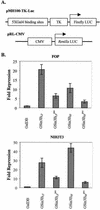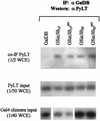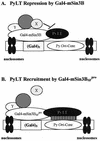Inhibition of polyomavirus ori-dependent DNA replication by mSin3B
- PMID: 12414923
- PMCID: PMC136908
- DOI: 10.1128/jvi.76.23.11809-11818.2002
Inhibition of polyomavirus ori-dependent DNA replication by mSin3B
Abstract
When tethered in cis to DNA, the transcriptional corepressor mSin3B inhibits polyomavirus (Py) ori-dependent DNA replication in vivo. Histone deacetylases (HDACs) appear not to be involved, since tethering class I and class II HDACs in cis does not inhibit replication and treating the cells with trichostatin A does not specifically relieve inhibition by mSin3B. However, the mSin3B L59P mutation that impairs mSin3B interaction with N-CoR/SMRT abrogates inhibition of replication, suggesting the involvement of N-CoR/SMRT. Py large T antigen interacts with mSin3B, suggesting an HDAC-independent mechanism by which mSin3B inhibits DNA replication.
Figures








Similar articles
-
E1A represses wild-type and F9-selected polyomavirus DNA replication by a mechanism not requiring depression of large tumor antigen transcription.J Virol. 1991 Jun;65(6):2921-8. doi: 10.1128/JVI.65.6.2921-2928.1991. J Virol. 1991. PMID: 1851864 Free PMC article.
-
AP1 enhances polyomavirus DNA replication by promoting T-antigen-mediated unwinding of DNA.J Virol. 1996 Aug;70(8):4914-8. doi: 10.1128/JVI.70.8.4914-4918.1996. J Virol. 1996. PMID: 8763994 Free PMC article.
-
Replication of damaged DNA in vitro is blocked by p53.Nucleic Acids Res. 2003 Jul 15;31(14):3881-92. doi: 10.1093/nar/gkg468. Nucleic Acids Res. 2003. PMID: 12853603 Free PMC article.
-
The emerging role of class II histone deacetylases.Biochem Cell Biol. 2001;79(3):337-48. Biochem Cell Biol. 2001. PMID: 11467747 Review.
-
Possible involvement of nuclear oncoproteins in regulation of DNA replication.Tohoku J Exp Med. 1992 Oct;168(2):183-7. doi: 10.1620/tjem.168.183. Tohoku J Exp Med. 1992. PMID: 1339100 Review.
Cited by
-
Histone deacetylase activity is necessary for chromosome condensation during meiotic maturation in Xenopus laevis.Chromosome Res. 2006;14(3):319-32. doi: 10.1007/s10577-006-1049-2. Epub 2006 Apr 20. Chromosome Res. 2006. PMID: 16628502
-
Inhibition of transcription and DNA replication by the papillomavirus E8-E2C protein is mediated by interaction with corepressor molecules.J Virol. 2008 Jun;82(11):5127-36. doi: 10.1128/JVI.02647-07. Epub 2008 Mar 19. J Virol. 2008. PMID: 18353941 Free PMC article.
References
-
- Alexiadis, V., L. Halmer, and C. Gruss. 1997. Influence of core histone acetylation on SV40 minichromosome replication in vitro. Chromosoma 105:324-331. - PubMed
-
- Alland, L., R. Muhle, H. Hou, J. Potes, L. Chin, N. Schreiber-Agus, and R. A. Depinho. 1997. Role for N-CoR and histone deacetylase in Sin3-mediated transcriptional repression. Nature 387:49-55. - PubMed
-
- Amin, A. A., Y. Murakami, and J. Hurwitz. 1994. Initiation of DNA replication by simian virus 40 T antigen is inhibited by the p107 protein. J. Biol. Chem. 269:7735-7743. - PubMed
-
- Ayer, D. E. 1999. Histone deacetylases: transcriptional repression with Siners and NuRDs. Trends Cell Biol. 9:193-198. - PubMed
Publication types
MeSH terms
Substances
Grants and funding
LinkOut - more resources
Full Text Sources
Research Materials

